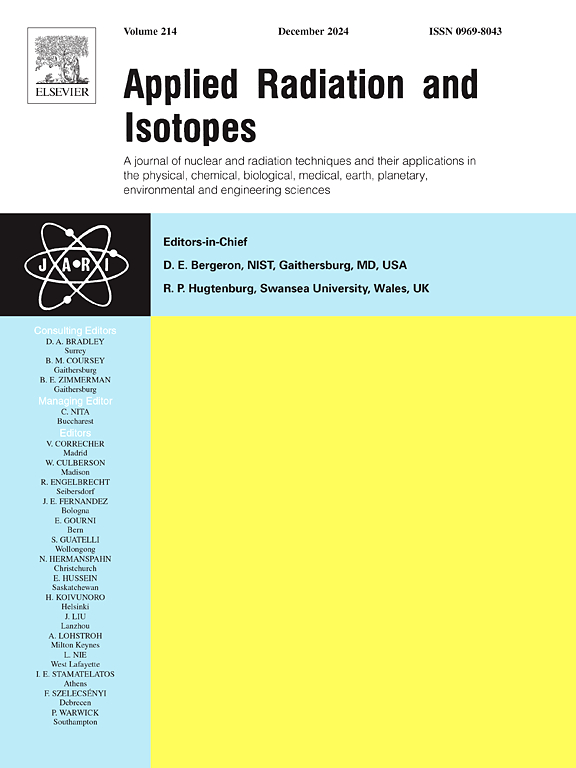确保核电厂退役放射性废物放射化学分析结果有效性的实验室间比较
IF 1.8
3区 工程技术
Q3 CHEMISTRY, INORGANIC & NUCLEAR
引用次数: 0
摘要
建立了移动放射化学分析实验室(MIRACLE),根据放射性水平对核电站退役过程中产生的放射性废物进行快速定性和分类。为了保证MIRACLE检测结果的准确性,我们在国内三个实验室进行了对比试验。为此,使用了一种由sus304制成的放射性液体标准物质(sus304 -liquid- rm),模拟不锈钢304的酸溶溶液,以及两种由头型混凝土(C-CRM)和土壤(S-CRM)组成的认证标准物质(CRM)。采用ISO 13528中规定的En-score方法,对SUS 304-liquid-RM、C-CRM和S-CRM中作为标准辐射源的60Co、134Cs、137Cs和90Sr的分析准确性进行了评估。如果En-score在- 1.0 <范围内,则认为结果令人满意;在& lt;1.0.对于SUS 304-liquid-RM中的60Co和137Cs,所有参与实验室报告的en分数在- 1.0 <范围内;在& lt;1.0,而对于134c, En-score大于1。值得注意的是,只有实验室a报告了90Sr(一种β辐射源)的En-score为0.2。对于C-CRM中的60Co和137Cs,只有lab-B报告的en分数在0 <范围内;在& lt;60Co和137Cs在整个放射性范围内为1。最后,对于S-CRM中的60Co和137Cs,所有参与的实验室都报告了在整个放射性范围内令人满意的en分数。本文章由计算机程序翻译,如有差异,请以英文原文为准。
Interlaboratory comparison for ensuring validity of radiochemical analysis results of NPP decommissioning radioactive wastes
A mobile radiochemical analysis laboratory (MIRACLE) was developed to quickly characterize and classify the radioactive wastes produced during the decommissioning of nuclear power plants by their radioactivity level. To ensure the accuracy of the results produced by MIRACLE, a comparative test was conducted involving three domestic laboratories. For this purpose, one radioactive liquid reference material made from SUS 304 (SUS 304-liquid-RM), simulating the acid dissolution solution of stainless steel 304, and two certified reference materials (CRM) consisting of bead-type concrete (C-CRM)and soil (S-CRM), were used.
The accuracy of the analyses for 60Co, 134Cs, 137Cs, and 90Sr, as standard radiation sources in the SUS 304-liquid-RM, C-CRM, and S-CRM, was evaluated using the En-score method as specified in ISO 13528. Results were deemed satisfactory if the En-score fell within the range of −1.0 < En < 1.0.
For 60Co and 137Cs in the SUS 304-liquid-RM, all participating labs reported En-scores within the range of −1.0 < En < 1.0, while for 134Cs, the En-score was greater than 1. Notably, only lab-A reported an En-score of 0.2 for 90Sr, a beta emitter.
For 60Co and 137Cs in the C-CRM, only lab-B reported En-scores within the range of 0 < En < 1 for 60Co and 137Cs across the entire radioactivity range.
Finally, for 60Co and 137Cs in the S-CRM, all participating labs reported satisfactory En-scores across the full range of radioactivity.
求助全文
通过发布文献求助,成功后即可免费获取论文全文。
去求助
来源期刊

Applied Radiation and Isotopes
工程技术-核科学技术
CiteScore
3.00
自引率
12.50%
发文量
406
审稿时长
13.5 months
期刊介绍:
Applied Radiation and Isotopes provides a high quality medium for the publication of substantial, original and scientific and technological papers on the development and peaceful application of nuclear, radiation and radionuclide techniques in chemistry, physics, biochemistry, biology, medicine, security, engineering and in the earth, planetary and environmental sciences, all including dosimetry. Nuclear techniques are defined in the broadest sense and both experimental and theoretical papers are welcome. They include the development and use of α- and β-particles, X-rays and γ-rays, neutrons and other nuclear particles and radiations from all sources, including radionuclides, synchrotron sources, cyclotrons and reactors and from the natural environment.
The journal aims to publish papers with significance to an international audience, containing substantial novelty and scientific impact. The Editors reserve the rights to reject, with or without external review, papers that do not meet these criteria.
Papers dealing with radiation processing, i.e., where radiation is used to bring about a biological, chemical or physical change in a material, should be directed to our sister journal Radiation Physics and Chemistry.
 求助内容:
求助内容: 应助结果提醒方式:
应助结果提醒方式:


